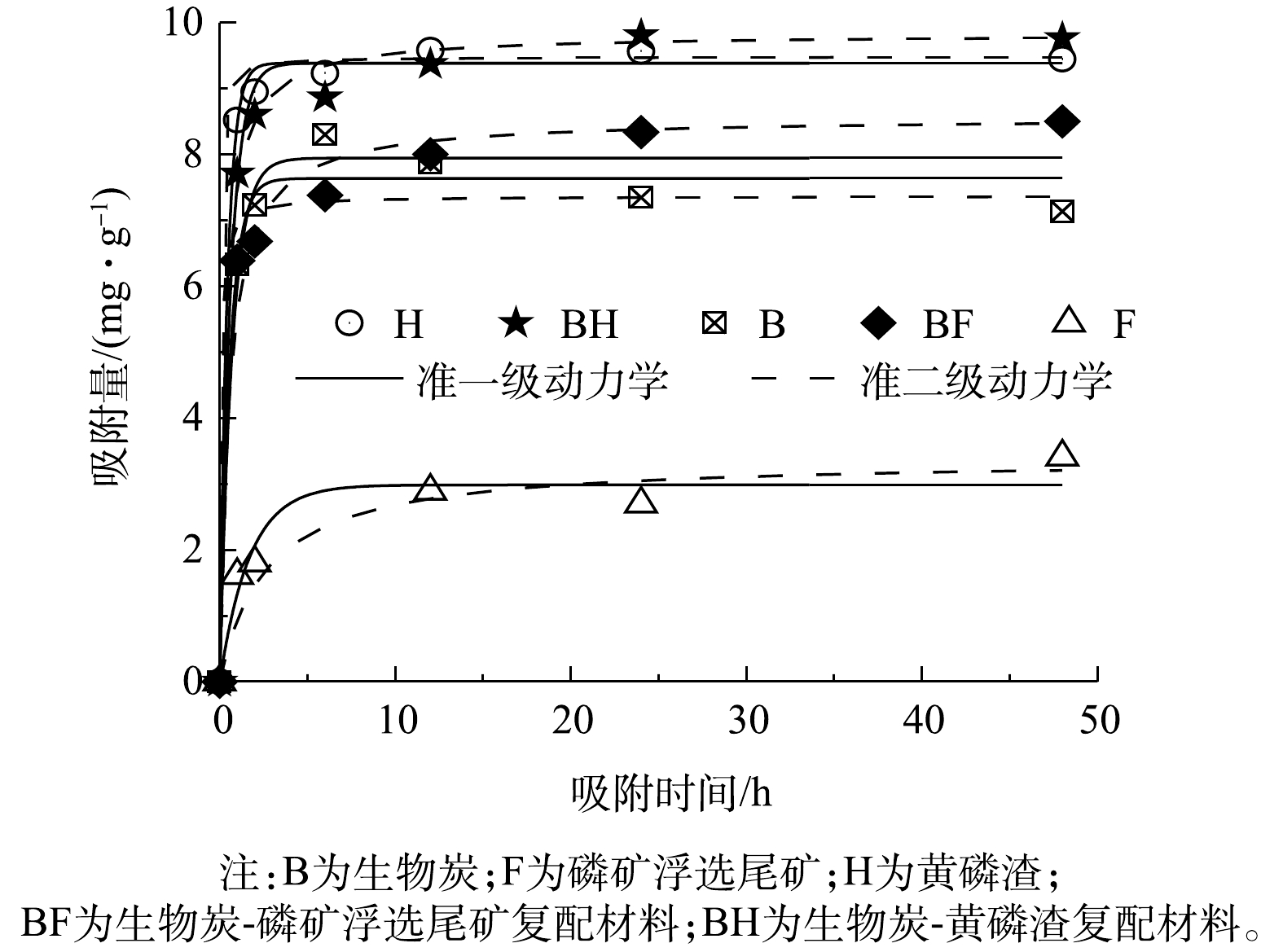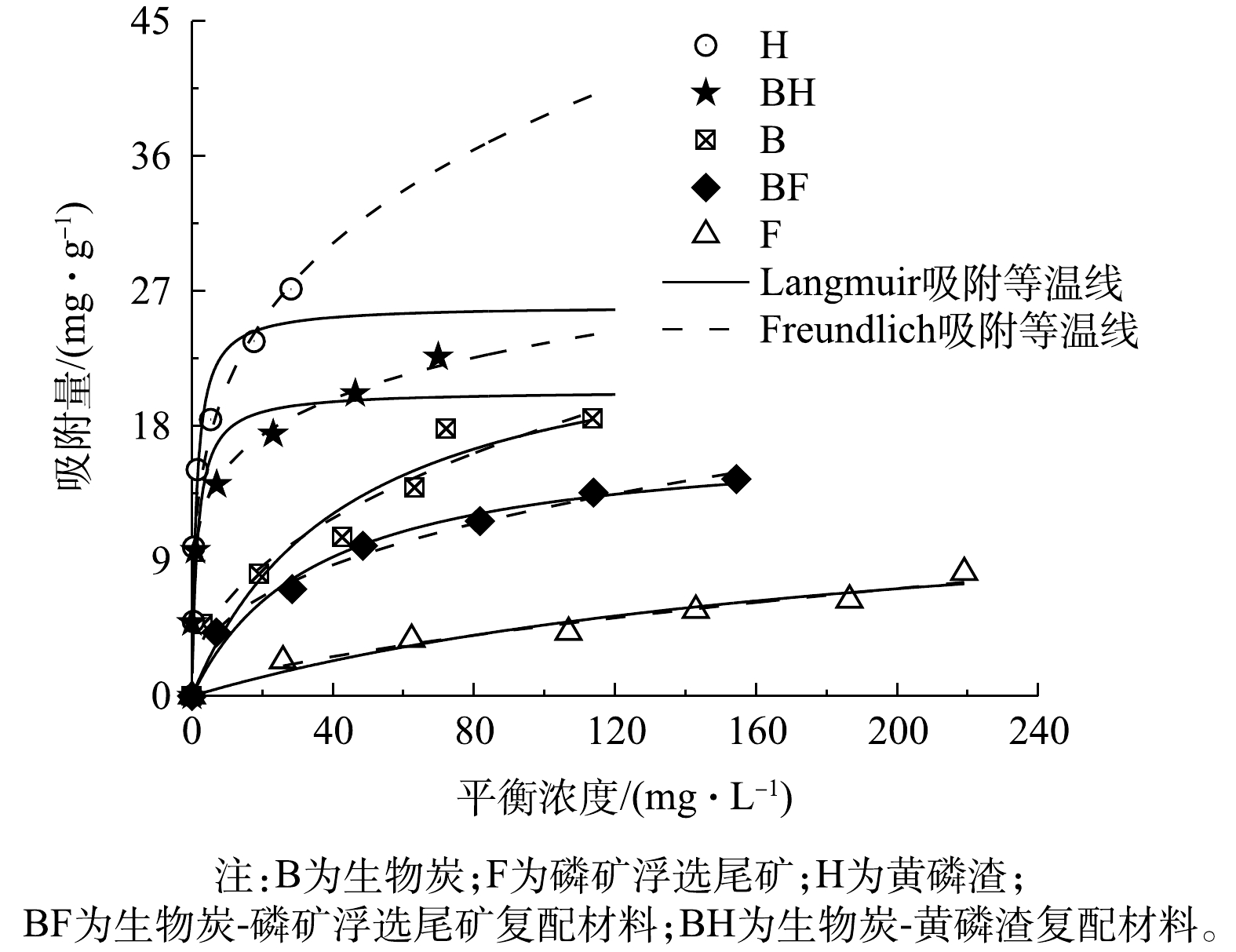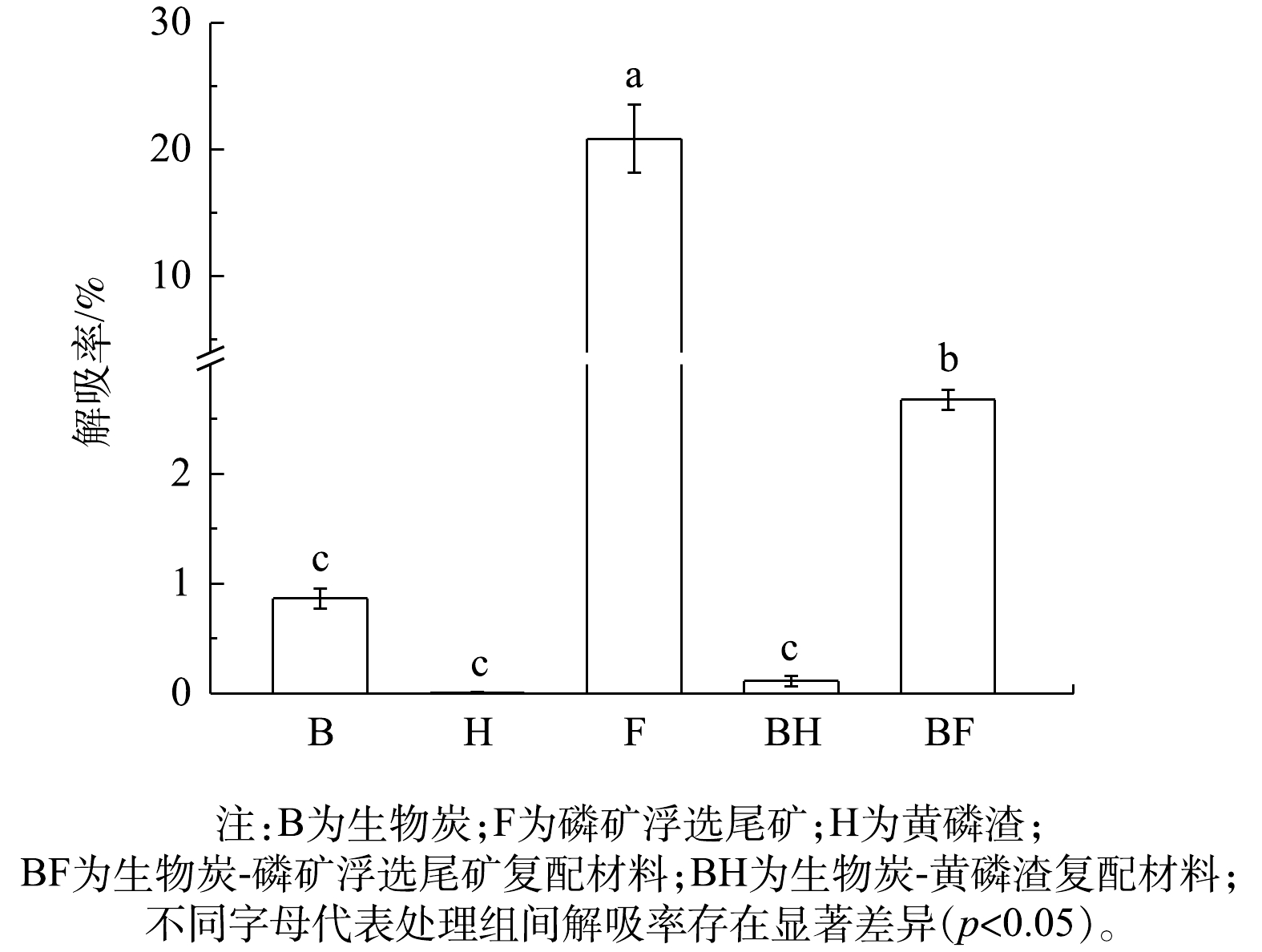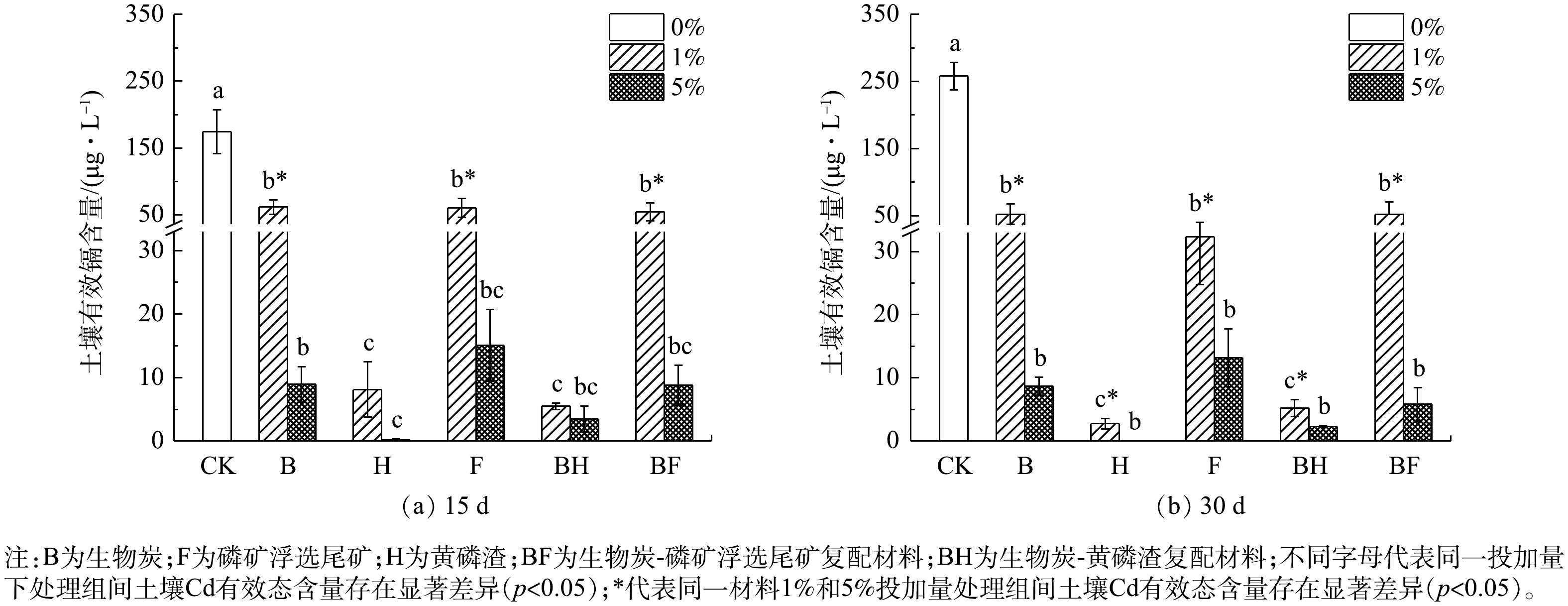-
镉(Cd)是典型的土壤重金属污染物之一,其易在土壤-植物系统间迁移,会造成农产品Cd含量超标,并能影响人群健康[1]。化学钝化修复技术通过向污染土壤中施用钝化材料,以降低土壤中Cd等重金属的迁移性,从而达到减少植物对重金属吸收的目的。该方法具有成本低、见效快、操作简便等优点[2]。生物炭和磷基材料是近年来较为热门的钝化材料。生物炭碱性强、比表面积高,表面含氧官能团丰富[3]。生物炭进入土壤环境后,主要通过表面吸附、离子交换、络合作用、π键作用等机制吸附重金属离子[4];同时,施用生物炭还能够提高土壤pH,进而达到降低重金属迁移性的目的[5]。有研究表明,生物炭具有钝化土壤重金属的潜力。 ZHANG等[6]发现,稻草生物炭的添加使2种不同污染水平的土壤中可交换态Cd降低了45%~62%。磷基材料主要包括过磷酸钙、钙镁磷肥、羟基磷灰石、磷矿粉等,其可以与土壤重金属污染物发生钝化反应。磷基材料与重金属离子作用机理包括:1)直接吸附重金属离子;2)
PO3−4 诱导间接吸附重金属离子;3)释放PO3−4 与重金属离子形成难溶的金属磷酸盐[7-8]。SESHADRI等[8]发现,磷酸氢二铵、活性天然磷酸盐岩和非活性天然磷酸盐岩这3种不同的磷基材料均能有效降低土壤重金属迁移性,土壤中Cd、Pb和Zn钝化率分别达到1.56%~76.2%、3.21%~83.56%和2.31%~74.6%。但是,许多钝化材料在实际应用中都存在一定的缺点和局限性,甚至产生次生环境风险。上述炭基和磷基材料也不例外,如生物炭材料施入土壤后,会受到各种生物和非生物过程影响,表面形貌和官能团分布发生变化,对重金属固定能力减弱[9],而施用磷基材料可能增加土壤环境磷流失风险[10]。2种或多种钝化材料复配使用,可以充分利用不同材料的优异性能,以达到提升土壤重金属污染修复效果。吴岩等[11]在轻度污染土壤中按等比复配的方式施加生物炭和沸石,结果表明复合材料提高了污染土壤pH,同时有效态Cd比例可降低56.78%,实现了pH和吸附性能的相互补充。周航等[12]发现,“羟基磷灰石+沸石”组配改良剂处理可显著降低土壤中重金属活性;Pb、Cd、Cu和Zn有效态含量分别降低了57.6%~80.1%、7.0%~40.9%、2.3%~22.7%和4.5%~33.2%。AHMAD等[13]通过生物炭负载磷酸盐矿物制备复合材料,能够有效增加土壤有效磷含量2~3倍,同时降低Pb、Zn和Cu有效态含量可分别达46.53%、32.34%和48.05%。钝化材料复配应用已成为土壤钝化修复技术领域的研究热点之一,但目前针对炭基和磷基材料的复配研究较少,复配材料对重金属的吸附特性及其土壤污染修复效果均有待深入探讨。
本研究以猪粪为原料制备生物炭材料,并选取2种磷矿废弃物作为磷基材料,随后采用物理复配方式制备2种不同的炭基和磷基复配材料。通过溶液实验体系探讨3种单一材料和2种复配材料对Cd2+的吸附-解吸特征;并采用室内培养实验,研究不同材料对污染土壤中Cd有效性和赋存形态的影响,为炭基和磷基复配材料修复土壤重金属污染提供参考。
全文HTML
-
采集猪粪样品,利用热裂解炉在500 ℃条件下,限氧热裂解2 h制备猪粪炭(B);材料自然冷却后研磨过2 mm筛,储存备用。2种磷矿废弃物来自云南磷化集团生产车间,分别为磷矿浮选尾矿(F)和黄磷渣(H),3种单一材料的理化性质如表1所示。材料F组分主要是氟磷灰石和二氧化硅等,总磷和有效磷含量分别为95.9和69.6 mg·kg−1;材料H主要由无定型硅酸盐和磷酸盐矿物组成,总磷和有效磷含量分别为7.1 g·kg−1和261.0 mg·kg−1。将2种磷矿废弃物分别和猪粪炭按质量比1∶1混合均匀,制备猪粪炭-浮选尾矿(BF)复配材料和猪粪炭-黄磷渣(BH)复配材料。
-
1)吸附动力学实验。称取四水合硝酸镉(Cd(NO3)2·4H2O),以0.01 mol·L−1 NaNO3为背景电解质溶液,配置100 mg·L−1 Cd2+溶液。称取0.300 0 g材料于100 mL三角瓶中,加入30 mL Cd2+溶液,置于恒温振荡器(SHZ-82A,金坛市科兴仪器厂)中以25 ℃、150 r·min−1振荡。分别于10、20、30、45、60、120、360、720、1 440和2 880 min取出0.30 mL样品,离心过滤,稀释,通过原子吸收光谱仪(M6,美国热电公司)测定Cd2+浓度,计算吸附量。每个处理组设置3个平行。
2)吸附等温线实验。称取0.050 0 g材料于15 mL离心管中,分别加入5 mL不同浓度Cd2+溶液(0、50、100、150、200、250和300 mg·L−1,以0.01 mol·L−1 NaNO3为背景电解质),置于恒温振荡器中以25 ℃、150 r·min−1振荡。48 h后,取样过滤,测定滤液Cd2+浓度,计算吸附量。每个处理组设置3个平行。
3)解吸实验。吸附等温线实验后,收集初始Cd2+浓度为300 mg·L−1实验组的固体样品,干燥后备用。称取0.100 0 g已吸附Cd2+的材料于离心管中,加入10 mL 0.01 mol·L−1 CaCl2解吸溶液,置于恒温振荡器中以25 ℃、150 r·min−1振荡48 h。取样过滤,测定滤液Cd2+浓度,计算解吸率。每个处理组设置5个平行。
4)室内土壤培养实验。供试土壤取自福建省晋江市井边村。土壤pH为5.44±0.05,有机质质量分数为(17.70±2.00) mg·g−1,阳离子交换量为(10.60±1.00) cmol·kg−1。土壤Cd质量分数为(2.02±0.05) mg·kg−1,超过农用地土壤污染风险筛选值(0.30 mg·kg−1)[14]。
将5种钝化材料以1%和5%添加量分别与土壤混合均匀,装入培养容器。添加去离子水,调节土壤含水率为土壤饱和持水量的60%,置于恒温培养箱(SPX-250,宁波海曙赛福实验仪器厂)在25 ℃培养。同时,设置不添加钝化材料的空白对照组(CK)。每个处理组设置4个平行。
在培养第15 d和第30 d时,分别取出部分土壤样品,冷冻干燥。利用pH计(STARTER 3100/F,上海奥豪斯仪器有限公司)测定土壤pH,水土比为2.5∶1(v/w)。采用CaCl2溶液浸提土壤有效态Cd[15],具体操作为:称取1.000 0 g土壤样品,加入10 mL 0.01 mol·L−1 CaCl2溶液,振荡2 h,离心过滤,通过电感耦合等离子体质谱仪(Agilent 7500cx,美国Agilent公司)测定Cd含量。土壤Cd有效态含量降低百分比的计算如式(1)所示。
采取Tessier 连续提取法分析土壤中Cd的赋存形态[16]。准确称取过2 mm筛的土壤样品1.000 0 g置于50 mL离心管中,按表2提取试剂及反应条件进行操作,通过电感耦合等离子体质谱仪测定Cd含量,计算土壤中不同形态Cd的比例。
1.1. 实验原料
1.2. 实验方法
-
1)钝化材料对Cd2+的吸附动力学特性。钝化材料对Cd2+的吸附动力学曲线如图1所示,5种材料对Cd2+的吸附动力学过程相似。随着时间增加,不同材料对Cd2+的吸附量逐渐增大,直至达到吸附平衡。材料B、F和H对Cd2+的吸附分别在2、12和2 h达到平衡,复配材料BF和BH对Cd2+的吸附均在6 h达到平衡。
通过准一级和准二级动力学模型拟合不同材料对Cd2+的吸附动力学过程,拟合参数如表3所示。2种动力学模型均能较好地拟合各材料对Cd2+的吸附过程,但准二级动力学模型拟合结果优于准一级动力学模型,拟合度R2均大于0.97。已有研究表明,磷基材料[18]和炭基材料[19]对重金属离子的吸附符合准二级动力学模型。朱司航等[20]也发现,小麦秸秆生物炭负载纳米羟基磷灰石前后对Cu2+的吸附均符合准二级吸附动力学模型。准二级动力学模型假设吸附速率由吸附剂表面未被占有的吸附空位数目的平方值决定,材料对吸附质的吸附过程受化学吸附机理控制,因此5种材料对Cd2+的吸附主要受化学吸附控制。
准二级动力学的速率常数k2反映材料对Cd2+的吸附速率快慢,其值越大,反应速度越快,达到平衡所需时间越短。BH和BF的k2值相近,这表明2种复配材料对Cd2+的吸附速率接近。与单一材料相比,不同的炭基和磷基复配材料对Cd2+的吸附速率变化较大,BH对Cd2+的吸附速率小于H,而BF高于F。通常材料pH和比表面积对Cd2+的吸附过程影响较大。磷矿浮选尾矿F与具有更高pH和比表面积的生物炭B复配后,材料BF的pH和比表面积均增加,对Cd2+的表面吸附位点增多,有利于离子扩散和离子交换[21],提高了BF对Cd2+的吸附速率。黄磷渣H和生物炭B的pH相近,但黄磷渣比表面积大于生物炭,复配后材料比表面积降低,使得BH对Cd2+的吸附速率小于H。
2)钝化材料对Cd2+的等温吸附特性。不同钝化材料对Cd2+的吸附等温线如图2所示。随着平衡质量浓度的增加,5种材料对Cd2+的吸附量逐渐增加。5种材料对Cd2+的吸附能力排序为F < BF < B < BH < H,其中复配材料BH对Cd2+的吸附量高于BF。模型拟合分析结果表明,Freundlich吸附等温线模型对5种材料的等温吸附实验数据拟合度高于Langmuir吸附等温线模型。Langmuir吸附等温线模型假定吸附质在均匀表面发生单层吸附,Freundlich吸附等温线模型假定吸附质在不均匀物质表面发生多分子层吸附。模型拟合结果表明,Cd2+在5种材料表面主要发生非均质吸附。生物炭表面存在羟基、酚羟基、羧基等多种表面官能团[4],可以通过离子交换、静电吸附、络合等多种机制与Cd2+发生吸附作用。磷基材料可以通过表面络合、诱导吸附、沉淀、共沉淀机制固定Cd2+[22]。因此,生物炭和磷基材料复配的钝化材料表面官能团更加多元化,对Cd2+的吸附机制也呈多样化。
Freundlich吸附等温线模型拟合参数Kf表示材料对离子的吸附强度,Kf值越高,吸附强度越大。通过比较Kf值大小发现,5种材料对Cd2+的吸附强度排序为:F < BF < B < BH < H。矿物溶解性和有效磷含量是影响磷矿物材料吸附重金属的重要因素[23]。在2种磷基材料中,磷矿浮选尾矿主要含难溶性氟磷灰石,结晶度高,稳定性强,有效磷含量低于黄磷渣。因此,表面吸附可能是磷矿浮选尾矿对Cd2+的主要作用机制。黄磷渣为无定型非晶质结构[24],有效磷含量高于260 mg·kg−1,表面可溶性磷酸盐易于溶解释放到环境中与Cd2+反应[25],且黄磷渣碱性较强,能够促进Cd2+在黄磷渣表面吸附、沉淀和共沉淀。这可能是黄磷渣对Cd2+的吸附强度高于磷矿浮选尾矿的主要原因。生物炭-磷矿浮选尾矿复配材料处理组的Kf值高于单一磷矿浮选尾矿处理组(表4)。这表明引入的生物炭提高了磷矿浮选尾矿材料对Cd2+的吸附强度。生物炭-黄磷渣复配材料处理组的Kf值小于单一黄磷渣处理组,生物炭降低了黄磷渣对Cd2+的吸附强度。这可能是由于生物炭对部分Cd2+的吸附为离子交换、静电作用等弱吸附机制,而黄磷渣对Cd2+的吸附主要为沉淀和共沉淀机制[26],吸附强度更高。此外,生物炭会通过表面吸附作用固定磷酸根离子[27],黄磷渣释放的大量磷酸根可能直接在生物炭上形成沉淀[28],降低游离的磷酸根浓度,从而减少材料对Cd2+的固定。
3)钝化材料对Cd2+的解吸特征。利用CaCl2解吸实验分析不同钝化材料对Cd2+的吸附稳定性,结果如图3所示,5种钝化材料对Cd2+的吸附稳定性存在较大差异。其中,磷矿浮选尾矿的吸附稳定性最差,Cd2+解吸率达20.86%,显著高于其他钝化材料。引入生物炭的复配材料BF的Cd2+解吸率较单一浮选尾矿材料F显著降低,为2.68%。这表明,复配增强了浮选尾矿材料对Cd2+的吸附强度。黄磷渣、生物炭和生物炭-黄磷渣处理组的Cd2+解吸率低于1%。这表明,3种材料对Cd2+的吸附稳定性较强,且材料处理间不存在显著差异。吸附稳定性对材料在土壤Cd污染修复应用潜力的意义较大。吸附稳定性高,材料表面吸附的重金属不易随环境条件变化发生二次释放,能够更有效地控制土壤重金属污染风险。BF对Cd2+的吸附稳定性高于F,与重金属离子的结合力较强,应用于土壤Cd污染修复后,其修复效果的稳定性可能更好;而含黄磷渣的材料均具有较强的吸附稳定性,在土壤污染修复中的应用价值优于含浮选尾矿的钝化材料。
-
1)钝化材料对土壤Cd有效性的影响。土壤重金属有效态是指利用化学试剂提取的土壤重金属部分,有研究表明,重金属有效态含量与植物可利用的重金属含量呈现很好的相关性[29],通常被认为是生物可利用部分,是评价重金属污染修复效果的重要指标。与对照相比,施用钝化材料的所有处理组均能显著降低土壤Cd有效态含量(图4)。培养30 d后,B、F、BF、H和BH处理组土壤Cd有效态含量分别降低了79.77%~96.64%、87.48%~94.89%、79.89%~97.75%、98.93%~99.99%和97.98%~99.10%;Cd有效态含量降低幅度随着材料添加比例的增加而增加。生物炭和磷基材料可以吸附Cd2+,进入土壤环境后会通过表面吸附、离子交换、络合、磷酸盐沉淀/共沉淀作用钝化土壤中Cd污染物,从而降低Cd的生物有效性[4, 30]。施用钝化材料还会提高土壤pH,其中复配材料处理提高土壤pH 0.67~1.84个单位。这可能是由于生物炭含有一定量的灰分,灰分中的矿质元素以碳酸盐或氧化物形式存在,溶于间隙水后会提高土壤pH[31];同时,磷基材料施入土壤后,释放的磷酸二氢根可被吸附在黏土颗粒上,导致土壤胶体表面的羟基释放量增加,使土壤pH也随之增加[32]。土壤重金属活性与pH呈负相关关系,土壤pH增加,即氢离子浓度降低,则土壤胶体的表面负电荷增加[33],有利于钝化重金属离子,从而降低土壤重金属迁移性。因此,施用生物炭、磷基材料或复配材料也会通过改变土壤pH影响Cd的有效性。
当材料施用量为1%时,黄磷渣或生物炭-黄磷渣复配材料处理下土壤Cd有效态含量显著低于其他材料处理组。这可能是由于黄磷渣pH高,对Cd的钝化性能强,当低剂量施用材料时,含黄磷渣的单一或复配材料均比含磷矿浮选尾矿的单一或复配材料体系有更好的重金属钝化表现。当施用量增加为5%时,与对照相比,所有材料均能显著降低土壤Cd有效态含量,但5种材料处理组之间土壤Cd有效态含量没有显著差异。
2)钝化材料对土壤Cd赋存形态的影响。土壤中Cd以多种化学形态存在,其中可交换态的可移动性最强。利用Tessier分级方法分析了钝化材料对土壤Cd赋存形态的影响,结果如图5所示。在对照土壤中,Cd主要以可交换态和碳酸盐结合态形式存在,2者占比总和超过60%,显著高于其他3种形态[34],表明土壤存在一定的Cd污染风险。施用钝化材料后,土壤Cd赋存形态发生变化,可交换态Cd比例显著降低。B、F、BF、H和BH处理下土壤可交换态Cd比例分别降低9.50%~24.48%、11.04%~20.00%、12.27%~22.25%、31.43%~39.53%和28.97%~36.39%,而活性较低的铁锰氧化物结合态、有机结合态和残渣态Cd比例增加。林爱军等[35]、雷鸣等[36]和LI等[37]的研究也得出相似的结果,即施用生物炭或磷基材料能够降低土壤重金属可交换态含量。曹永强等[38]的研究也表明,将生物炭和磷肥复配施入重金属污染土壤,土壤可交换态Cd含量减少,碳酸盐结合态、铁锰氧化物结合态、有机结合态和残渣态Cd含量增加。本研究中,添加5种钝化材料处理后,土壤中Cd均向更稳定形态转化,降低了土壤重金属污染风险。
复配材料BH处理组的土壤可交换态Cd比例比H处理组高1.71%~5.31%,BF处理组的土壤可交换态Cd比例比F处理组降低1.23%~2.91%。但是,复配材料处理下土壤可交换态Cd降低幅度与相应磷基材料处理间不存在显著差异。这与土壤Cd有效态含量变化趋势相似,当施用量达到或超过1%后,复配材料与单一材料对Cd2+的吸附容量差异不影响材料对土壤Cd污染的钝化修复效果。除了直接吸附土壤中的Cd污染物外,钝化材料还能够通过提高土壤pH实现对重金属迁移性的降低作用。材料BH和H处理下土壤pH不存在显著差异,BF和F处理下土壤pH也不存在显著差异(数据未显示)。在高pH条件下,土壤可交换态Cd易于向更稳定形态转化,这可能是复配材料与单一磷基材料钝化效果相近的原因。本研究中亦发现,几种钝化剂混合施用对重金属污染土壤的修复作用不一定优于其单独添加的修复效果,这和李飞跃等[39]的研究结果相似。该研究中发现,生物炭复配矿物质处理对土壤重金属的钝化效果介于生物炭处理和矿物质处理之间,与土壤pH变化趋势相一致。因此,pH被认为是影响实验中钝化材料应用效果的关键因素。
外源物质添加可能会对土壤环境产生不确定的影响,甚至风险。生物炭和磷基材料在土壤质量改良、肥力提升等农业应用中有多重效益[40-41]。然而,有报道指出,生物炭或者磷基材料过量使用可能会在稳定重金属的过程中对土壤和植物产生一些负面影响,如增加土壤碱度[42],提高磷流失风险[10]。因此,合理控制材料添加量非常重要。在本研究中,炭基和磷基复配材料未表现出明显的协同作用,但通过复配能够减少单一生物炭和单一磷矿废弃物的施用量,从而在保证修复效果的基础上,降低由于大量施用生物炭或磷基材料可能产生的环境风险。因此,发展合适的复配材料在土壤重金属污染修复的实践中具有长远意义。
2.1. 钝化材料对溶液中Cd2+的吸附-解吸特性
2.2. 钝化材料对污染土壤中Cd有效性和赋存形态的影响
-
1)材料B、H、F、BH和F对Cd2+的吸附均符合准二级吸附动力学模型,表明吸附过程主要受化学吸附影响。BF和BH对Cd2+的吸附均在6 h内达到平衡,吸附速率高于F而低于B或H。
2) 5种材料对Cd2+的吸附能力排序为:H > BH > B > BF > F。Freundlich吸附等温线模型对5种材料对Cd2+的吸附结果拟合度高于Langmuir吸附等温线模型,Cd2+在材料表面发生非均质吸附。
3)材料F的Cd2+解吸率显著高于其他处理组,BH、H和B处理组解吸率均低于1%,对Cd2+的吸附稳定性较好。
4) 5种钝化材料均可显著降低土壤Cd有效态含量,促进土壤中可交换态Cd向更稳定形态转化。炭基材料复配磷基材料处理未表现出加和效应,钝化效果介于单一生物炭处理和单一磷基材料处理之间。其中,炭基和磷基复配材料BH的Cd钝化效果显著优于BF,表明生物炭和黄磷渣制备的炭基和磷基复配材料在土壤Cd污染修复中具有较好的应用前景。




 下载:
下载:








